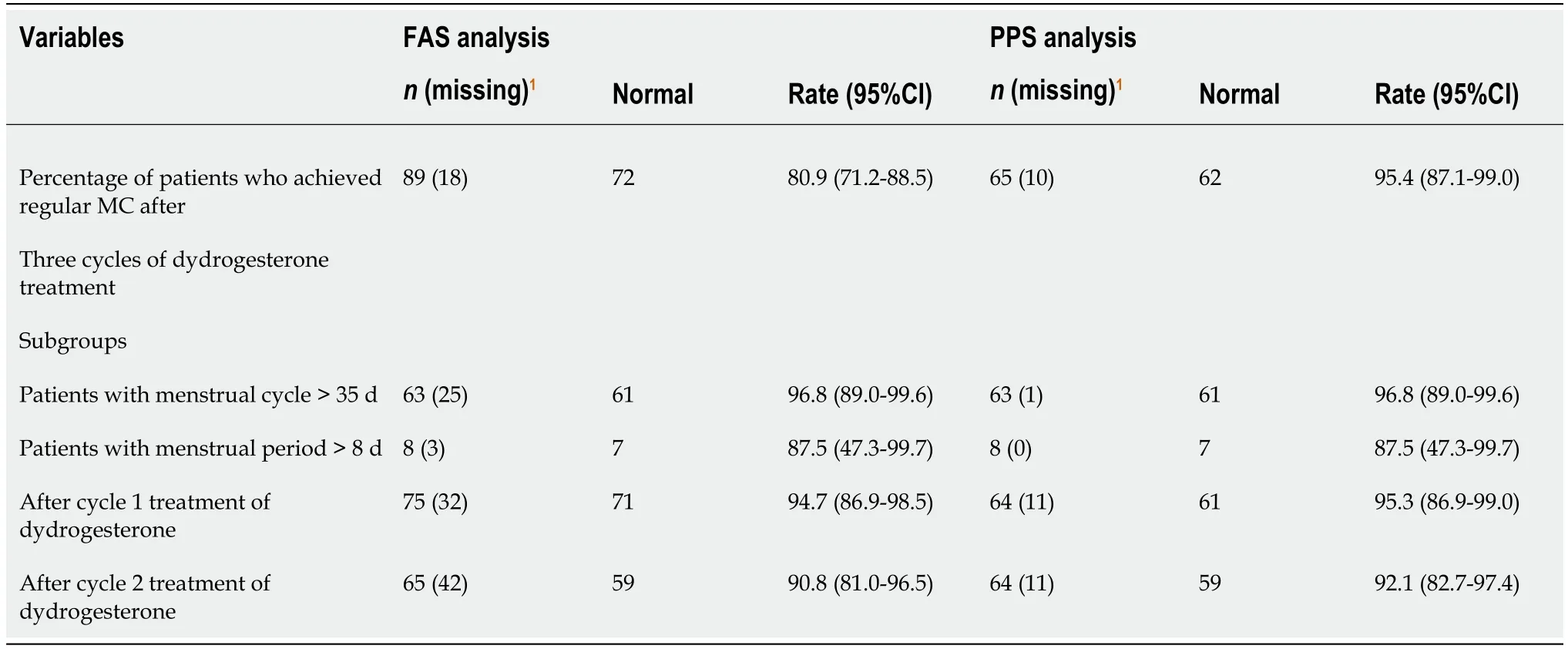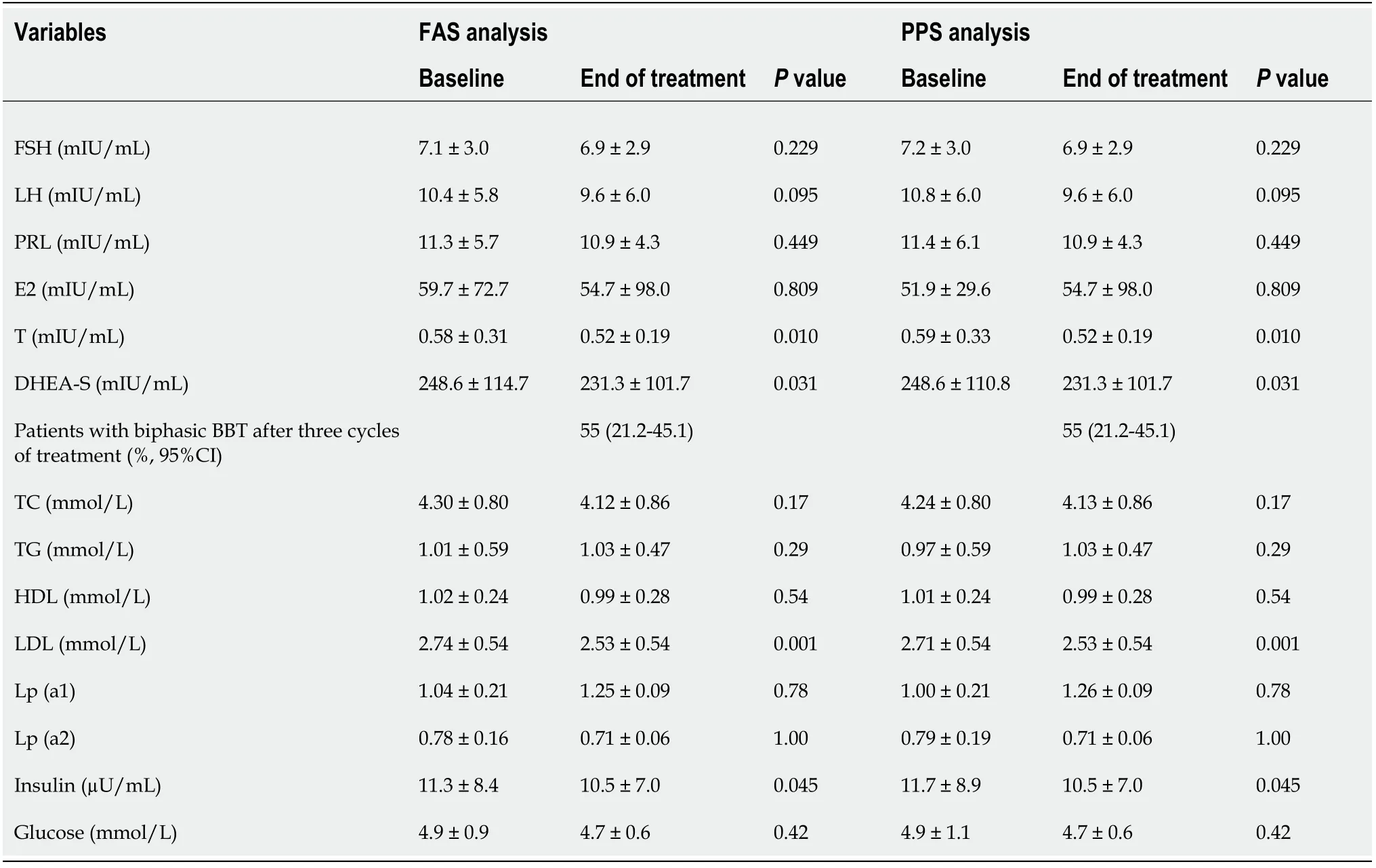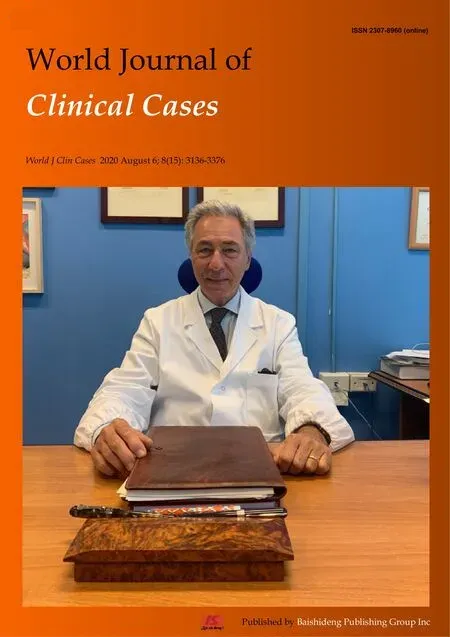Dydrogesterone treatment for menstrual-cycle regularization in abnormal uterine bleeding–ovulation dysfunction patients
Lu Wang, Hai-Yun Guan, He-Xia Xia, Xiu-Ying Chen, Wei Zhang
Lu Wang, Hai-Yun Guan, He-Xia Xia, Xiu-Ying Chen, Wei Zhang, Department of Reproductive Endocrinology, Obstetrics and Gynecology Hospital of Fudan University, Shanghai 200011,China
Abstract
Key words:Dydrogesterone;Abnormal uterine bleeding-ovulation dysfunction;Menstrual cycle;Hormone;Testosterone;Dehydroepiandrosterone sulfate
INTRODUCTION
The normal interval of menstrual cycle (MC) is typically 21 to 35 d and duration of normal menstrual flow is generally 5 d[1].Abnormal uterine bleeding, which is defined as bleeding from the uterine corpus that is abnormal in volume, regularity, and/or timing, continues to pose significant physical and financial burdens on patients[2,3].Abnormal uterine bleeding - ovulatory dysfunction (AUB-O) is a subtype of AUB which has been newly classified by the International Federation of Gynecology and Obstetrics (FIGO), manifesting heavy and irregular uterine bleeding due to the absence of ovulation and formation of corpus luteum[4].It is widely accepted that AUBO is caused by the deficiency of progesterone and the unopposed secretion of estrogens, leading to a sustained endometrial proliferation without progesteronewithdrawal-induced shedding[5].
One strategy for the treatment of irregular menstrual cycle due to AUB-O is using progestins to schedule orderly withdrawal bleeding by stopping endometrial growth and transforming estrogen-primed endometrium.For this purpose, dydrogesterone has displayed remarkable advantages.Dydrogesterone is an orally active retroprogesterone, a stereoisomer of progesterone, which differs slightly in molecular structure from natural progesterone.In addition, its retrostructure endows dydrogesterone with a highly selective property binding to the progesterone receptor[6].However, although increasing evidence showed the good efficacy of dydrogesterone in treating menstrual disorders[3,7-10], studies focusing its efficacy for AUB-O patients are limited, especially in China where synthetic progestins are commonly prescribed for hemostasis and menstrual cycles regulation.Thus, the present prospective, single center, observational study was designed to assess the effectiveness of dydrogesterone for menstrual cycle regularization in Chinese AUB-O patients.
MATERIALS AND METHODS
Patients
We recruited a total of 114 female patients aged 16 years or above with menses, who were suffering from irregular MCs for at least 3 mo and diagnosed with AUB-O and treated with dydrogesterone for cycle regulation, between December 2013 and February 2015.All patients were administered oral dydrogesterone, 1 tablet (10 mg)twice daily from day 16 to 25 of each cycle, consecutively for at least 3 cycles.In this observational study, whether patients were treated with dydrogesterone was decided by the physicians based on their clinical experience.
Exclusion criteria included the use of oral contraceptives, sex hormone or glucocorticoid in the past 1 mo, the history of hyperprolactinemia, thyroid dysfunction or estrogen-deficiency-related symptoms.Patients who were pregnant, lactating,ineligible for the study according to physician’s discretion or presented with the contraindications listed in the Chinese label of dydrogesterone were also excluded.The study protocol was approved by the Ethics Committee, Obstetrics and Gynecology Hospital of Fudan University, Shanghai, China.Written informed consent was obtained from each participant.The study was registered in Clinical Trials.gov(ID:NCT02029144).
Patient visits were scheduled based on routine practice of the physicians.However,it would be preferable to have the following 3 visits for each patient:(1) Any day before day 16 of cycle 1;(2) Any day between cessation of withdrawal bleeding of cycle 1 and day 16 in cycle 2;and (3) Any day within 1 wk after cessation of withdrawal bleeding of cycle 3.All patients were required to fill up a diary card to capture the information pertaining to the study variables including date of last menstrual period, duration of menstrual cycle (in days), duration of menstrual bleeding (in days), date of medication and basal body temperature (BBT).The data of the subjects were collected between December 2013 and February 2015.Authors had access to information that could identify individual participants during data collection.
Efficacy variables
The primary objective was to observe the percentage of patients whose menstrual cycles returned to normal (defined as 21 d
Safety parameters included the changes of insulin, glucose and lipid levels and adverse events.Tabulation of adverse events (AEs) classified by relationship with the investigational product and whether the AE resulted in withdrawal was performed.
Statistical analysis
Since this was an observational, non-randomized, single-arm study, the sample size of 114 subjects was not based on statistical power considerations.However, available literature suggested that dydrogesterone was effective in regularizing cycle in 91.6%patients with irregular cycle.Based on a precision of 7%, about 74 subjects were required.In addition, considering the long duration of study with around 35% drop out, a total of 110 patients need to be enrolled in this study.
Statistical analysis was conducted using SAS (SAS Institute Inc., Cary, NC, United States).Continuous data were described using mean and standard deviation.Categorical data were reported in frequency and percentage with 95% confidence interval.Pairedttest was used for within-group comparison of data before and after treatment, and McNemarχ2test was carried out for within-group rate comparison before and after treatment.A two-sidedPvalue ≤ 0.05 was regarded as statistically significant.Full analysis set (FAS) was determined according to the intention-to-treat(ITT) principle, including all subjects who were included in this study and who had taken at least dydrogesterone once.Per-protocol set (PPS) was a subset of FAS,including all subjects who fulfilled the trial protocol.Safety set (SS) included subjects who had taken at least dydrogesterone once and had received at least one postadministration safety evaluation.
RESULTS
The flow chart of enrollment of patients is shown in Figure 1.A total of 114 patients were enrolled in this study, all of whom were included in the FAS and SS.Eighty(70.2%) patients finished the follow-up and were included in PPS.The main reason for withdrawal was loss to follow-up.The baseline and demographic characteristics of these patients are summarized in Table 1.
In FAS, 72 of 89 patients (80.9%) (18 with missing data) achieved regular MC at the end of three cycles of dydrogesterone treatment.For the patients in PPS, 62 of 65 patients (95.4%) (10 with missing data) achieved cycle regularization over the treatment period (Table 2).Seven subjects in FAS and 5 subjects in PPS who had a normal baseline menstrual cycle (defined as 21 d After cycle one treatment, proportion of subjects with regular MC was 94.7% (71/75,32 with missing data) in FAS and 95.3% (61/64, 11 with missing data) in PPS.The proportion was 90.8% (59/65, 42 with missing data) and 92.1% (59/64, 11 with missing data) at the end of two cycles of therapy in FAS and PPS, respectively (Table 2).Among the patients with a menstrual cycle >35 d, 61 were evaluated as “effective”,accounting for 96.8% (Table 2) and the difference in the length of menstrual cycles before (68.7 ± 25.6 d) and after (29.1 ± 2.4 d) treatment was statistically significant (P<0.0005) both in FAS and PPS.Similarly, 87.5% (7/8) of the patients whose menstrual period >8 d achieved regular MC after dydrogesterone treatment (Table 2).Among those patients, the menstrual period averaged 19.4 ± 14.6 d before treatment and 6.0 ±1.4 d after three cycles of dydrogesterone treatment, decreasing by 15.6 ± 17.8 d on average (P=0.042).Interestingly, 44 (55.0%) subjects had biphasic BBT during the period of treatment (Table 3). Either in FAS analysis or in PPS analysis, the levels of sex hormones including FSH,LH, prolactin and estrogen 2, did not show statistically significant differences before and after treatment with dydrogesterone.In contrast, both androgen testosterone (T)and dehydroepiandrosterone sulfate (DHEA-S) significantly decreased (Table 3). Among the 114 subjects included in the present study, three (2.6%) experienced three AEs, which were considered unrelated to the investigated drug.Interestingly,treatment with dydrogesterone demonstrated moderate beneficial effects on blood lipid and glucose metabolism (Table 3).Of note, significant reduction of low-density lipoprotein (P=0.001) and insulin (P=0.045) was detected. Figure 1 Flow chart of enrollment of subjects. The effectiveness and safety of dydrogesterone for the treatment of AUB-O in Chinese women was evaluated in this observational study.Overall, 95.4% of patients gained cycle regularization after dydrogesterone treatment in PPS.In the subgroup analysis,the recovery ratewas more than 87% whilst the median MC duration for patients with polymenorrhea or oligomenorrhea was 29.1 d at the end of therapy, within the normal cycle (21-35 d).These results are comparable to the results of previous studies where regularization of MCs restored by dydrogesterone was discovered in 86.8%-99.1% of patients and the mean MC duration after treatment was around 27.7-29.8 d[7,9-11]. It has been reported that the response induced by dydrogesterone was equal to or greater than other orally administered progestins on eliciting secretory phase activity including norethindrone, medroxyprogesterone acetate, norgestrel and progesterone[12].A recent post-marketing observational investigation containing 996 subjects with irregular MCs by Podzolkovaet al[9]demonstrated that 99.1% of patients achieved >1 regular MC and 79.1% maintained >6 regular MCs after treatment with dydrogesterone, suggesting that cycle regularization may sustain over time after dydrogesterone treatment[9]. Table 1 Baseline and demographics of the study population (full analysis set) Table 2 Percentage of patients who achieved regular menstrual cycles after dydrogesterone treatment Actually, the absence of clinically relevant androgenic, estrogenic, glucocorticoid or mineralocorticoid activities makes dydrogesterone more pronounced compared to other progestin regimens[13]such as medroxyprogesterone acetate (anti-gonadotropic and glucocorticoid effect), norethisterone (anti-gonadotropic, estrogenic and androgenic effect) and levonorgestrel (anti-gonadotropic and androgenic effect)[6,14,15].Additionally, a previous research comparing the systematic biochemical characterization of dydrogesterone and progesterone suggested no androgenic and mild antiandrogenic effects of dydrogesterone[16].These are in line with our results that dydrogesterone did not affect the levels of FSH, LH, prolactin and estrogen 2 apart from reducing the concentration of androgen T and DHEA-S.The fact that 55%subjects presented biphasic BBT in the present study indicates that dydrogesterone at least does not inhibit ovulation and this is in agreement with the earlierinvestigation[17].It is conceivable that dydrogesterone promoted ovulation function through regulating LH meanwhile restraining the estrogen T and DHEA-S. Table 3 Sex hormone, lipid, insulin and blood glucose level after three cycles of treatment and biphasic basal body temperature during the treatment Although a number of studies as above-mentioned have established the clear significant advantages of dydrogesterone for various menstrual disorders, there are limited data on the efficacy of dydrogesterone on AUB-O since the definition of AUBO was recommended to describe uterine bleeding abnormalities by FIGO in 2011.For this point, the results of our study may be of a greater reference value for the application of dydrogesterone in patients with AUB-O. In contrast with other progestins, dydrogesterone appears to be largely neutral in terms of biochemical markers and indirect clinical endpoints[18,19].Dydrogesterone did not exert to undermine the beneficial effects of oestradiol on low density lipoproteins or insulin based on a previous prospective study[20], which is concordant with a randomized controlled research indicating that dydrogesterone beneficially influence the serum lipids when sequentially combined with oestradiol[21].With respect to insulin sensitivity, Dansuket al[22]found that dydrogesterone combining with 17 βestradiol enhanced insulin sensitivity in postmenopausal women with 3 mo of treatment[22].In addition, the safety of dydrogesterone has been confirmed in previous literature[7,9-11].The associated AEs were also recorded throughout the treatment in the present study.Only three AEs occurred during the study, none of them was considered to be related to dydrogesterone. We are very cautious about our results because of two major limitations of the present study.Firstly, as most observational studies, the present study was limited by the absence of placebo or control group, and the relative short follow-up on 3 cycles of treatment.In addition, lack of stratification by age or reproductive status and relatively small sample size may also weaken the statistical power of this exploratory analysis. In summary, dydrogesterone therapy was effective in achieving MC regularization in Chinese patients with AUB-O.In addition, the neutral effects of dydrogesterone on sex hormones as well as the metabolic level reiterate its role in regulating irregular menstrual cycles.Moreover, the drug was well tolerated by patients.To further confirm our findings, more studies with a larger sample size, longer follow-up and generally accepted nomenclature of menstrual disorders would be highly desirable. Abnormal uterine bleeding - ovulation dysfunction (AUB-O) is caused by the deficiency of progesterone and the unopposed secretion of estrogens, leading to a sustained endometrial proliferation without progesterone-withdrawal-induced shedding.Dydrogesterone has shown significant efficacy in the treatment of irregular menstrual cycle due to AUB-O. Although increasing evidence showed the good efficacy of dydrogesterone in menstrual disorders, few studies are available focusing its efficacy for AUB-O patients,especially in China where synthetic progestins are commonly prescribed for hemostasis and menstrual cycle regulation. Our study aimed to evaluate the effects of dydrogesterone on menstrual-cycle (MC)regularization and metabolism in the patients with AUB-O. Women aged 16 years or above with AUB-O were treated with dydrogesterone orally 1 tablet (10 mg) twice daily from day 16 to 25 of each cycle and consecutively for at least 3 cycles, the primary objective was to observe the percentage of patients whose MCs returned to normal (defined as 21 d Seventy-two (80.9%) of the 89 patients achieved a regular MC at the end of the 3rdcircle treatment, and the level of androgen, including testosterone and dehydroepiandrosterone sulfate, declined significantly (P=0.01 and 0.031, respectively). Dydrogesterone therapy was effective in achieving MC regularization for Chinese patients with AUB-O. This observational study suggested that dydrogesterone was effective and safe for the treatment of AUB-O in Chinese women.More studies with a larger sample size, longer follow-up and generally accepted nomenclature of menstrual disorders would be highly desirable. ACKNOWLEDGEMENTS The authors would like to thank all members for offering help in the study.
DISCUSSION



ARTICLE HIGHLIGHTS
Research background
Research motivation
Research objectives
Research methods
Research results
Research conclusions
Research perspectives
 World Journal of Clinical Cases2020年15期
World Journal of Clinical Cases2020年15期
